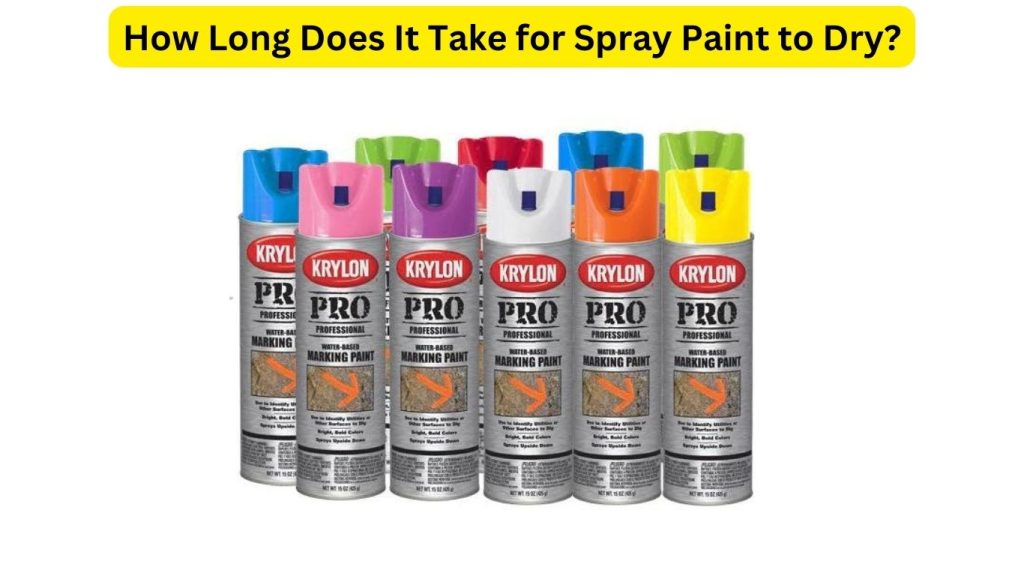The drying time of spray paint depends on various factors such as the type of paint, environmental conditions, and thickness of the application.

Generally, spray paint dries to the touch within minutes, but complete curing may take several hours to several days. Understanding the factors that influence drying time is crucial for achieving optimal results.
In this guide, we’ll delve into the factors affecting spray paint drying time, tips for speeding up the process, and how to determine when your paint is fully cured for handling and reapplication.
Let’s explore the fascinating world of spray paint drying times!
Contents
How Long Does It Take for Spray Paint to Dry?
Spray paint drying times vary based on factors like material type, paint formulation, and environmental conditions. Understanding these variables is essential for achieving optimal results.
In this comprehensive guide, we’ll explore the drying times of spray paint on various materials such as wood, metal, plastic, and fabric. We’ll discuss factors influencing drying times, tips for speeding up the process, and how to determine when paint is fully cured for handling.
Whether you’re painting furniture, automotive parts, or DIY projects, this guide will help you navigate the drying process effectively for professional-looking results.
- Understanding Spray Paint Drying Time:
- Factors influencing drying time
- Importance of temperature, humidity, and ventilation
- Spray Paint Drying Times on Different Materials: a. Wood:
- Porous nature affecting absorption and drying
- Typical drying time range
- Considerations for bare metal vs. primed surfaces
- Effect of metal composition on drying time
- Challenges with adhesion and flexibility
- Prepping techniques to improve paint adherence
- Expected drying time on various plastic types
- Specialized fabric spray paints vs. traditional paints
- Drying time on different fabric types (cotton, polyester, etc.)
- Tips for Speeding Up Spray Paint Drying Time:
- Using thin, even coats
- Optimal distance and technique for spraying
- Using fast-drying or high-temperature paints
- Accelerating drying with fans or heaters (caution required)
- Determining Full Cure and Reapplication:
- Difference between drying and curing
- Testing paint tackiness and hardness
- Waiting for complete cure before handling or reapplying coats
- Special Considerations:
- Matte vs. gloss finishes and their impact on drying time
- UV-resistant and weatherproof coatings for outdoor applications
- Compatibility of multiple paint layers and drying times between coats
- Conclusion:
- Recap of factors influencing spray paint drying time
- Importance of patience and proper conditions for optimal results
- Applying knowledge of drying times to enhance your painting projects on various materials
How To Make Spray Paint Dry Faster?
Waiting for spray paint to dry can be time-consuming, but there are methods to speed up the process safely.
In this comprehensive guide, we’ll explore various techniques for accelerating spray paint drying times.
From adjusting environmental conditions to using specialized products and tools, we’ll cover everything you need to know to get your projects dried faster and achieve professional-looking results in less time.
- Understanding Spray Paint Drying Time:
- Factors influencing drying time
- Importance of temperature, humidity, and ventilation
- Tips for Accelerating Spray Paint Drying: a. Environment Adjustment:
- Choose a warm, dry day for painting
- Paint in a well-ventilated area or outdoors
- Use fans or air movers to increase airflow
- Apply thin, even coats of paint
- Maintain the recommended distance between the spray can and the surface
- Avoid over-application to prevent drips and runs
- Use fast-drying spray paint formulations
- Consider paint additives designed to accelerate drying time
- Use heat guns or hairdryers on low heat to gently warm the painted surface
- Exercise caution to avoid overheating or blistering the paint
- Prepping Surfaces for Faster Drying:
- Ensure surfaces are clean and free of dust and debris before painting
- Use primers or surface prep products designed to promote adhesion and faster drying
- Post-Painting Techniques:
- Avoid touching or handling freshly painted surfaces until fully dry
- Place painted objects in a warm, dry area with good airflow to facilitate drying
- Special Considerations:
- Matte vs. gloss finishes and their impact on drying time
- Drying times for different materials (wood, metal, plastic, etc.)
- Compatibility of multiple paint layers and drying times between coats
- Safety Precautions:
- Follow all safety instructions and precautions provided on paint labels
- Use protective equipment such as gloves, goggles, and respirators when necessary
- Conclusion:
- Recap of techniques for accelerating spray paint drying time
- Importance of patience and proper application techniques
- Achieving professional-looking results with faster drying times
Final Words
Spray paint drying times vary depending on the material being painted, environmental conditions, and paint formulation.
By understanding these factors and following the tips outlined in this guide, you can achieve professional-looking results on wood, metal, plastic, fabric, and other materials.
Whether you’re a DIY enthusiast or professional painter, mastering the drying process is key to successful projects with spray paint.
